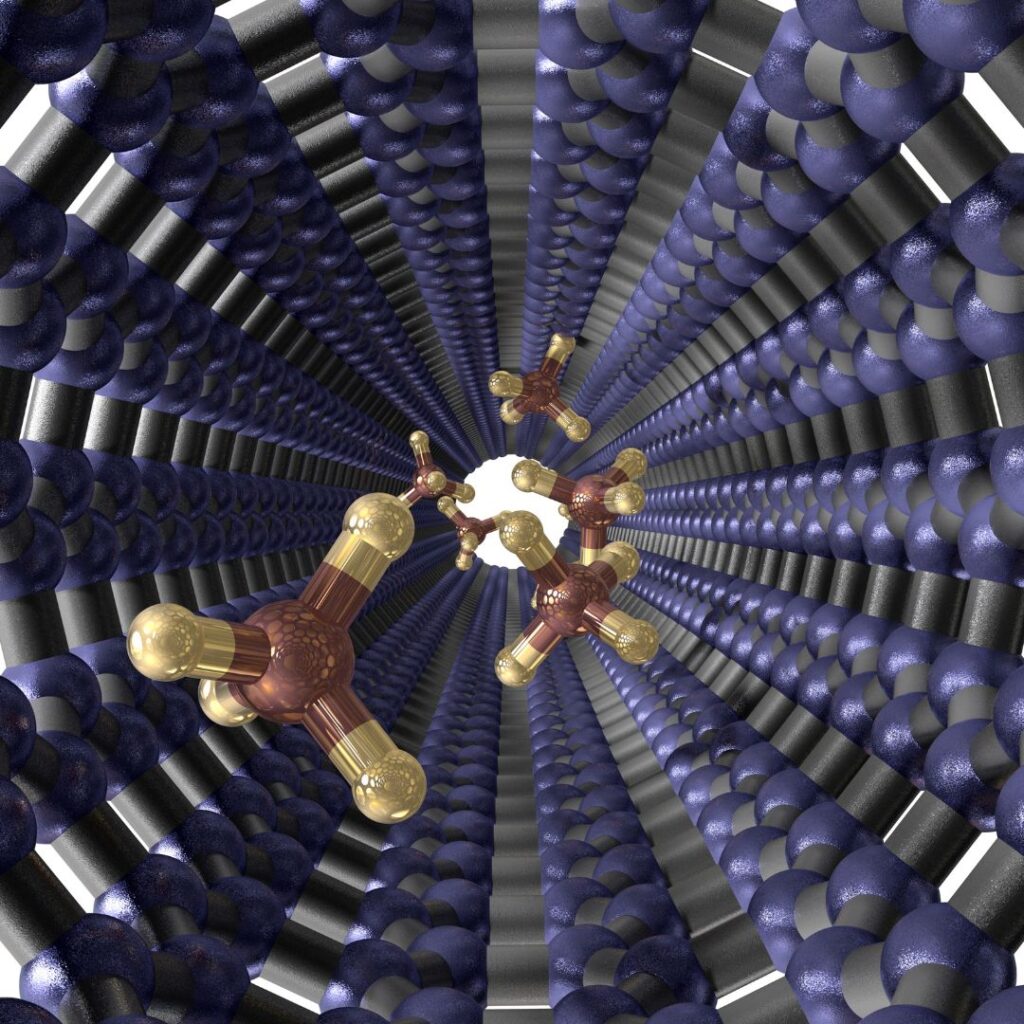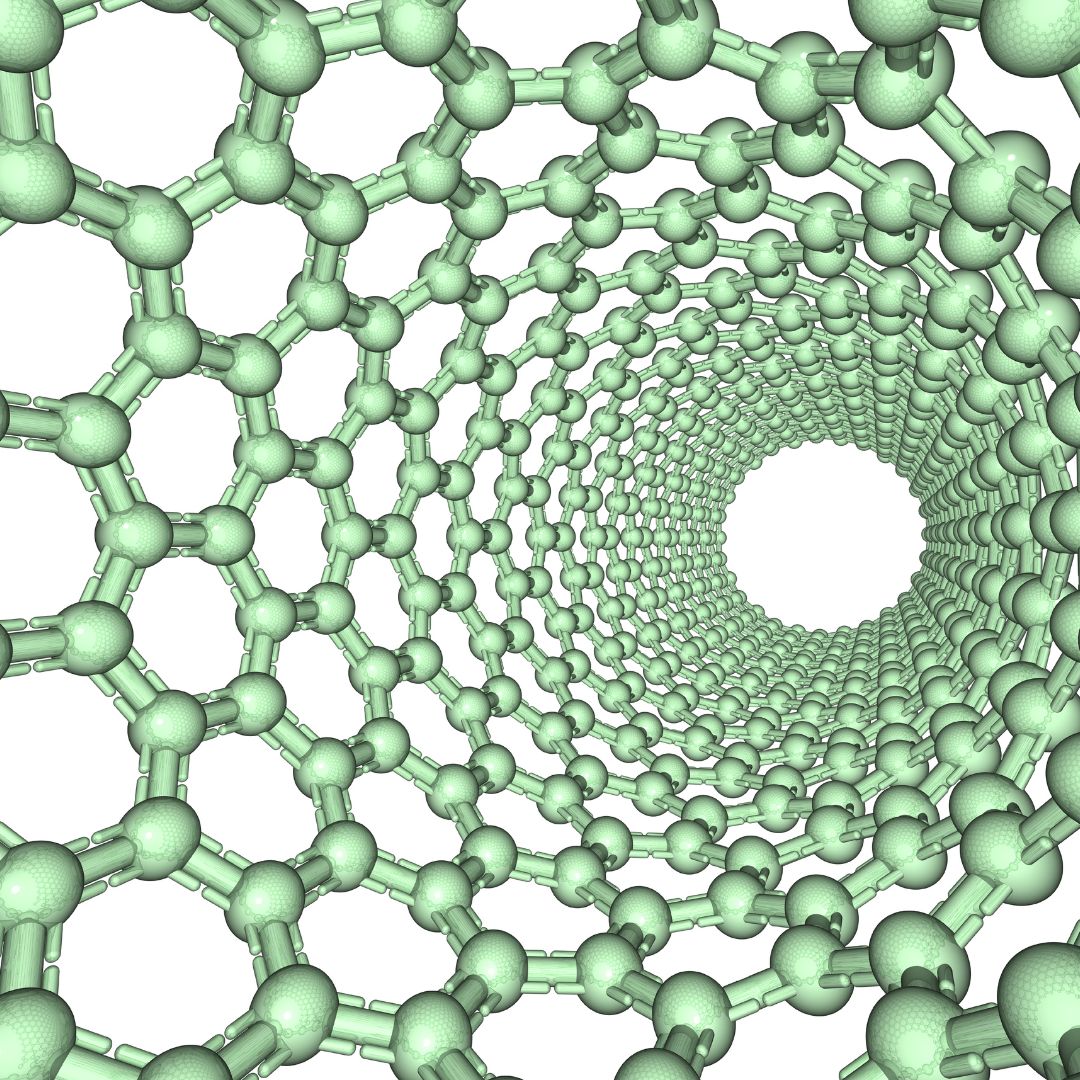Carbon nanotubes have captured the imagination of scientists and engineers due to their unique physical and chemical properties and potential applications across various industries. As we harness the power of these nanomaterials, it is crucial to understand their human and the environmental impact of carbon nanotubes
This FCC-NA blog delves into the intricate relationship between the environmental impact of carbon nanotubes, exploring their synthesis, dispersion, ecological interactions, and the broader implications for sustainability using the carbon nanotube forms.
Learn More About FCC-NA’s Innovative Technology Today!
Definition and Structure
Carbon nanotubes are cylindrical nanostructures composed of carbon atoms arranged in a hexagonal lattice. They can be single-walled carbon nanotubes or multi-walled carbon nanotubes, with diameters typically measured in nanometers. Their exceptional strength, electrical conductivity, and thermal properties make them highly desirable for applications ranging from electronics to medicine.
Applications in Various Industries
Carbon nanotubes are utilized in numerous sectors, including electronics, energy storage, automotive, aerospace, and biomedicine. They enhance the performance of batteries and capacitors, improve the strength of composite materials, and enable innovations in drug delivery systems. However, the rapid integration of carbon nanotubes into products raises concerns about their environmental footprint.
Production Processes and Environmental Concerns
Production processes for single-wall carbon nanotubes as well as multi-wall carbon nanotubes present significant environmental concerns due to the synthesis methods, emissions, waste generation, and potential hazards to ecosystems.
Synthesis Methods
Carbon nanotubes are typically synthesized using methods such as chemical vapor deposition (CVD), arc discharge, and laser ablation. Each method has its own environmental implications:
- Chemical Vapor Deposition (CVD): This process involves high temperatures and often utilizes catalysts and carbon-containing gases. It consumes significant energy and requires careful management of precursor gases, which can include toxic substances like carbon monoxide.
- Arc Discharge: This process involves high-energy electric arcs between carbon electrodes in an inert atmosphere. It can generate metal nanoparticles as by-products, which require disposal management.
- Laser Ablation: The process uses laser pulses to vaporize a carbon target in an inert gas atmosphere. It produces fewer hazardous carbon nanomaterials and by-products compared to other methods but still requires energy-intensive laser equipment.
Emissions and Waste Generation
The production of carbon nanotubes can result in emissions of greenhouse gases and hazardous by-products. Synthesis processes like CVD can emit carbon dioxide and other greenhouse gases, contributing to climate change. At the same time, various synthesis methods can generate toxic by-products such as metal catalyst residues, carbon monoxide, and other volatile organic compounds.
These by-products need careful handling and treatment to prevent environmental contamination and reduce the environmental impact of carbon nanotubes. Managing these emissions and minimizing waste generation are critical challenges for the industry.
Potential Hazards to Ecosystems
The release of carbon nanotubes into the environment, whether during production, usage, or disposal, poses potential risks to ecosystems. Carbon nanotubes have been shown to have toxic effects on aquatic organisms and terrestrial species in certain conditions. There are also concerns about carbon nanotubes accumulating in organisms and potentially entering food chains, posing long-term risks to ecosystems and human health. Understanding these hazards is essential for developing mitigation strategies.
FCC-NA’s influence spans the globe, with facilities located worldwide. As a conscientious corporate entity, FCC-NA is dedicated to environmental stewardship and not contributing negatively to the environmental impact of carbon nanotubes. We adhere to environmental regulations and meet customer expectations by implementing waste reduction processes, advocating for pollution prevention, and conserving natural resources through sustainable manufacturing practices.
Learn More About FCC-NA’s Innovative Technology Today!
Dispersion and Transport in the Environment
The dispersion and transport of carbon nanotubes in the environment are complex processes influenced by their behavior in air, water, and soil, as well as various environmental factors.
Behavior in Air, Water, and Soil
Carbon nanotubes can disperse in the air, water, and soil, and are influenced by specific factors. In airborne form, carbon nanotubes can disperse over long distances, depending on their aerodynamic properties and environmental conditions. Factors such as particle size and surface chemistry influence their behavior in the atmosphere and thus the environmental impact of carbon nanotubes.
In aqueous environments, carbon nanotubes can disperse as individual nanotubes or form agglomerates depending on their surface charge, hydrophobicity, and the presence of natural organic matter or other particles. Their mobility in water bodies affects their potential exposure to aquatic organisms.
Finally, when released into the soil, carbon nanotubes can interact with soil particles and organic matter, influencing their transport and potential uptake by plants and soil-dwelling organisms.
Factors Influencing Dispersion
Environmental factors, including temperature, pH, and the presence of organic matter, play a significant role in the dispersion and stability of carbon nanotubes in different environments. Variations in temperature and pH can alter the surface properties of carbon nanotubes, affecting their dispersibility in water and interactions with soil. However, natural organic matter in water and soil can adsorb onto carbon nanotube surfaces, influencing their aggregation behavior and mobility. Salinity and ionic strength can affect the electrostatic interactions between carbon nanotubes and environmental matrices, impacting their dispersion and transport.
Long-term Effects on Environmental Systems
The long-term persistence of the environmental impact of carbon nanotubes as well as their transformation in the environment, remain areas of active research, with implications for ecosystem health and regulatory policies. Carbon nanotubes can persist in the environment for extended periods of time due to their chemical stability. Their slow degradation raises concerns about potential accumulation in ecosystems as their physical, chemical, and biological processes can modify the structure and properties of carbon nanotubes over time, influencing their environmental behavior and toxicity.
However, research, indicates that carbon nanotubes can affect organisms at various trophic levels, from primary producers to higher consumers, with potential consequences for ecosystem structure and function.
Ecotoxicity and Biological Interactions
The ecotoxicity and biological interactions of carbon nanotubes are critical areas of study due to their potential to affect various components of ecosystems.
Impact on Microorganisms
Carbon nanotubes can affect microbial communities, altering their composition and function. This environmental impact of carbon nanotubes, in turn, can impact nutrient cycling and ecosystem stability. Carbon nanotubes can impact the diversity and abundance of microbial populations. A study curated by the Advance Pharmaceutical Bulletin has shown that carbon nanotubes can inhibit the growth of certain bacteria and fungi, potentially leading to shifts in microbial community structure.
Effects on Plant Life
Carbon nanotube exposure can have varying effects on plant growth. Another study found in the Environmental Technology & Innovation Journal reports enhanced growth and biomass production, while others indicate stunted growth and reduced biomass. Carbon nanotubes can also influence photosynthetic activity and root morphology. The effects of carbon nanotubes on plants can depend on several factors, including the type of plant, the concentration, the type of carbon nanotubes, and environmental conditions. Therefore, context-specific studies are essential to understanding the range of possible impacts.
Bioaccumulation and Biomagnification
The potential for carbon nanotubes to bioaccumulate in organisms and biomagnify through food chains poses significant ecological and health risks:
- Bioaccumulation: Carbon nanotubes can be taken up by various organisms, including microorganisms, plants, invertebrates, and vertebrates. This bioaccumulation can occur through direct exposure or through the ingestion of contaminated food or water.
- Biomagnification: As carbon nanotubes move up the food chain, their concentration can increase at higher trophic levels. This biomagnification can lead to higher exposure levels in predators, including humans, raising concerns about potential toxic effects.
Carbon Nanotubes in Aquatic Environments
The presence and impact of carbon nanotubes in aquatic environments, such as oceans, rivers, and lakes, are critical concerns due to their potential adverse effects on aquatic ecosystems.
Presence in Oceans, Rivers, and Lakes
Carbon nanotubes can enter aquatic environments through various pathways. Factories and production facilities may release carbon nanotubes directly into water bodies during manufacturing processes or through wastewater. Rainwater runoff from urban areas, agricultural lands, and construction sites can carry carbon nanotubes into rivers, lakes, and eventually oceans. Also, substances released into the air can settle into water bodies through precipitation or dry deposition.
Effects on Aquatic Organisms
Carbon nanotubes can interact with a range of aquatic organisms, causing various effects:
- Microorganisms: Carbon nanotubes can inhibit the growth and metabolic activity of bacteria, algae, and other microorganisms. This can disrupt primary production and nutrient cycling, essential processes for ecosystem health.
- Invertebrates: Exposure to carbon nanotubes can lead to physiological stress, behavioral changes, and mortality in invertebrates such as zooplankton and benthic organisms. These changes can affect food webs and nutrient dynamics.
- Fish: Carbon nanotubes can accumulate in fish, leading to gill damage, oxidative stress, and impaired reproductive and developmental processes. This can reduce fish populations and alter aquatic biodiversity.
- Bioaccumulation: Carbon nanotubes can accumulate in the tissues of aquatic organisms, potentially leading to biomagnification as they move up the food chain, posing risks to predators, including humans.
Remediation Strategies
Effective strategies to mitigate the impact of carbon nanotubes in aquatic environments include:
- Physical Removal: Techniques such as filtration, sedimentation, and flotation can physically remove carbon nanotubes from water. Advanced filtration technologies, like membrane filtration and nanofiltration, are particularly effective.
- Chemical Treatments: Chemical methods, such as coagulation and flocculation, can aggregate carbon nanotubes into larger particles that are easier to remove. Additionally, advanced oxidation processes (AOPs) can degrade carbon nanotubes into less harmful substances.
- Bioremediation: Utilizing microorganisms to degrade or immobilize carbon nanotubes offers a sustainable remediation approach. Research is ongoing to identify and optimize microbial strains capable of breaking down carbon nanotubes.
- Regulatory Measures: Implementing strict regulations on the discharge of carbon nanotubes into water bodies and promoting best practices in industries that utilize carbon nanotubes for fewer environmental releases.
With FCC-NA, you get the peace of mind of knowing that all our core products and technology are carefully considered in every step of our advanced materials production processes to ensure the highest level of quality and environmental stewardship.
Learn More About FCC-NA’s Innovative Technology Today!
Carbon Nanotubes and Soil Health
The interaction of carbon nanotubes with soil health involves concerns about soil contamination, impacts on microbial communities, and agricultural implications, necessitating effective remediation techniques and careful assessment of their use in agriculture.
Soil Contamination and Remediation Techniques
As discussed above, carbon nanotubes can contaminate soils, affecting their structure and fertility. Remediation techniques, such as phytoremediation and bioremediation, are being explored to address the issues regarding the environmental impact of carbon nanotubes.
Influence on Soil Microbial Communities
Soil microbial communities are vital for soil health, nutrient cycling, and plant growth, but the environmental impact of carbon nanotubes causes disruptions to these systems. Exposure to carbon nanotubes can reduce microbial diversity, leading to an imbalance in soil ecosystems and the dominance of certain species, which can undermine ecological functions. Additionally, carbon nanotubes can impair microbial metabolic activities like nitrogen fixation, organic matter decomposition, and enzyme production, altering nutrient cycling and soil fertility.
Moreover, interactions between carbon nanotubes and soil organisms, such as earthworms and insects, can affect these organisms’ health and behavior, further influencing soil structure and nutrient dynamics.
Agricultural Implications
The use of carbon nanotubes in agriculture, such as in fertilizers and pesticides, requires careful assessment to balance benefits with potential environmental risks. While carbon nanotubes can be used to develop advanced fertilizers and pesticides, the long-term accumulation of carbon nanotubes in agricultural soils can pose risks to soil health. Potential adverse effects include toxicity to plants and soil organisms, disruption of soil microbial communities, and contamination of groundwater. To ensure the safe use of carbon nanotubes in agriculture, comprehensive risk assessments are needed.
Airborne Carbon Nanotubes: Risks and Mitigation
The risks associated with airborne carbon nanotubes highlight the need for a thorough understanding of inhalation exposure, addressing respiratory health concerns, and implementing effective protective measures in occupational settings.
Inhalation Exposure
Airborne carbon nanotubes pose significant risks when inhaled, as they can penetrate deep into the respiratory system. Carbon nanotubes can become airborne during manufacturing processes, handling, and disposal of materials containing carbon nanotubes. Workers in industries such as electronics, materials science, and nanotechnology are particularly at risk. The nanoscale size of CNTs allows them to remain suspended in the air for extended periods, increasing the likelihood of inhalation.
Respiratory Health Concerns
Research indicates that exposure to carbon nanotubes can lead to respiratory issues, including inflammation and fibrosis. A Toxicology study has shown that inhaled carbon nanotubes can cause inflammation in the lungs, leading to symptoms such as coughing, wheezing, and shortness of breath. Chronic inflammation can damage lung tissue over time. Carbon nanotubes have also been linked to pulmonary fibrosis, a condition characterized by the formation of scar tissue in the lungs. This can impair lung function and lead to serious health complications. Protecting workers and the public, especially those with pre-existing respiratory conditions, such as asthma or chronic obstructive pulmonary disease (COPD), is paramount.
Protective Measures for Occupational Settings
Effective protective measures to reduce carbon emissions and their effects, such as ventilation systems and personal protective equipment, establishing standard operating procedures in the workplace, training, and awareness, along with regulatory compliance, are essential to minimizing inhalation exposure in workplaces handling carbon nanotubes.
FCC-NA prioritizes safety and health as core aspects of our business operations to minimize workplace injuries and accidents. We adhere to State and Federal regulations and enforce our own health and safety standards. Through comprehensive risk assessments, we aim to create a low-risk work environment.
Learn More About FCC-NA’s Innovative Technology Today!
Life Cycle Assessment of Carbon Nanotubes
A life cycle assessment of carbon nanotubes evaluates their environmental impacts from cradle to grave. This assessment is critical for understanding the sustainability of carbon nanotubes, comparing them with alternative materials, and guiding their development and application in a more environmentally responsible manner.
Assessing Environmental Impacts from Cradle to Grave
Life cycle assessments examine each stage of their life cycle, providing insights into the environmental impact of carbon nanotubes.
- Raw Material Extraction: Extracting raw materials like graphite or hydrocarbons for carbon nanotube synthesis involves energy use, land impact, and emissions from mining and processing.
- Synthesis and Production: Carbon nanotube production methods (CVD, arc discharge, laser ablation) are energy-intensive and generate emissions, requiring evaluation of energy use, greenhouse gases, and hazardous by-products.
- Product Manufacturing: Integrating carbon nanotubes into products (electronics, composites) impacts the environment through energy use, material efficiency, and waste generation.
- Usage Phase: Evaluates the performance benefits (strength, conductivity, efficiency) and potential environmental impacts (wear, emissions) of carbon nanotube-enhanced products.
- End-of-Life Disposal: Assesses disposal or recycling of carbon nanotube products, including recycling potential, energy recovery, and impacts of waste management processes like incineration or landfill.
Comparative Analysis with Alternative Materials
Life cycle assessments enable the comparison of carbon nanotubes with alternative materials to identify more sustainable options:
- Material Performance: Comparing carbon nanotubes with carbon fibers, metals, or polymers determines if carbon nanotube benefits outweigh their environmental impacts.
- Environmental Trade-offs: Assessing carbon nanotubes and alternatives helps identify trade-offs, such as higher production energy demands versus superior mechanical properties.
- Life Cycle Benefits: Carbon nanotubes may extend product lifespan, reduce weight, or improve energy efficiency, offsetting initial environmental impacts. Life cycle assessments quantify and compare these benefits to alternatives.
Sustainable Development Perspectives
Integrating sustainability into the development and application of carbon nanotubes is essential for minimizing their ecological footprint. Perspectives to consider are:
- Eco-design: Promoting eco-design principles in the development of carbon nanotube-based products can reduce the environmental impact of carbon nanotubes. This includes selecting sustainable raw materials, optimizing production processes for energy efficiency, and designing for recyclability.
- Green Synthesis: Developing greener synthesis methods for carbon nanotubes, such as using renewable energy sources or less hazardous precursors, can significantly reduce their environmental impact. Research into alternative synthesis techniques that lower energy consumption and emissions is crucial.
- Regulatory and Policy Frameworks: Implementing regulatory and policy frameworks that encourage sustainable practices in the carbon nanotube industry can drive innovation and the adoption of environmentally friendly technologies. Standards and guidelines for the responsible production and disposal of CNTs are essential.
- Public Awareness and Education: Raising awareness about the environmental impacts of carbon nanotubes and promoting sustainable practices among manufacturers, consumers, and policymakers can foster a culture of sustainability in the nanotechnology sector.
FCC-NA is leading the pack with pioneering new core technologies to leverage raw material integration, precise structural and shape control technologies. With our years of expertise in friction material manufacturing, we innovate bespoke materials that meet our customers’ specific requirements.
Learn More About FCC-NA’s Core Technologies Today!
Future Outlook: Innovations and Challenges
The future outlook for carbon nanotubes is shaped by a dynamic interplay of technological innovation, rigorous scientific research, and sustainable practices.
Advancements in Green Nanotechnology
Innovations in green nanotechnology aim to reduce the environmental impact of carbon nanotubes and promote sustainability through eco-friendly synthesis methods, waste minimization, and innovative applications. By developing synthesis methods that utilize renewable resources, lower energy consumption, and produce fewer hazardous by-products, green nanotechnology fosters more sustainable practices. Efforts to minimize waste and enhance recycling processes during carbon nanotube production can recover valuable materials and reduce raw material extraction.
Additionally, creating biodegradable nanocomposites helps mitigate carbon nanotube persistence in ecosystems. Sustainable applications, such as in renewable energy technologies, water purification, and lightweight materials for transportation, further support environmental sustainability.
Addressing Knowledge Gaps through Research
Continued research is needed to fill knowledge gaps, particularly regarding long-term environmental effects and safe handling practices. This includes:
- Environmental Impact: Comprehensive studies on carbon nanotube persistence, transformation, and bioaccumulation in various environments to inform risk assessments and regulations.
- Toxicity and Safety: Investigating carbon nanotube toxicity mechanisms to develop safer variants and establish exposure limits, along with safe handling practices for workers.
- Lifecycle Analysis Improvements: Enhancing Lifecycle Analysis methodologies to accurately capture carbon nanotube environmental impacts across their lifecycle with better data and modeling.
- Biological Interaction: Studying carbon nanotube interactions with biological systems to understand potential health and ecological effects, guiding the development of effective and biocompatible carbon nanotubes.
Balancing Technological Progress with Environmental Protection
Achieving a balance between technological advancement and environmental stewardship requires several key approaches. First, establishing and enforcing robust regulations for safe carbon nanotube production, use, and disposal based on scientific evidence. Next, set guidelines to promote responsible manufacturing and application of carbon nanotubes, prioritizing environmental protection and worker safety. Then engaging scientists, industry leaders, policymakers, and the public to address challenges collaboratively for effective solutions. And finally, educating consumers and stakeholders about carbon nanotube benefits and risks will encourage sustainable practices and informed decisions.
Conclusion
The field of nanotechnology is constantly evolving, and so is our understanding of the environmental impact of carbon nanotubes. We’ll continue to explore advancements in green nanotechnology, while highlighting efforts to create carbon nanotubes with a minimal environmental footprint as we strive to balance technological progress with environmental protection.
Let this article serve as a starting point for further discussion and collaboration with FCC-NA. Let’s work together to ensure that the incredible potential of carbon nanotubes is harnessed for a sustainable future and a future in advanced clutch technology.





